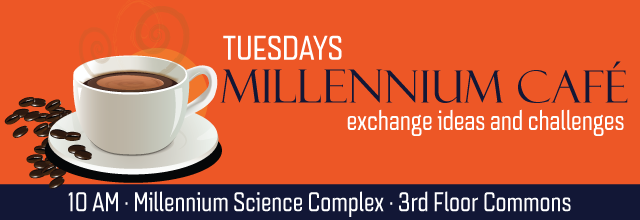
The fall semester Millennium Café has concluded. Enjoy the holiday and winter break. We will see you when we return in January 2026!

The fall semester Millennium Café has concluded. Enjoy the holiday and winter break. We will see you when we return in January 2026!
In nature, symbiosis is a survival strategy. In science, it is an innovation strategy—but it rarely happens by accident. At the One Health Microbiome Center, we are not just studying ecosystems; we are engineering one. I will discuss how we intentionally fuse distinct disciplines, linking a unified vision with the data scientist’s algorithm, the ecologist's field trial, and the technologist’s state-of-the-art platforms. By "designing" this collision and training bilingual, industry-academia PhDs through our NIH T32 BIOMS program, we are creating a culture where technology, biology, and scholars co-evolve. This is symbiosis by design, ensuring that our collective output is far greater than the sum of our individual labs.
Seth Bordenstein | Biology & Entomology, One Health Microbiome Center
Solid waste accumulation is a major challenge. Recycling efforts, spurred by material shortages after World War II, led to near zero-waste manufacturing and compostable plastics. Yet composites remain difficult to recycle. These materials are critical for lightweight electric vehicles, aerospace, defense, energy systems, and construction. The global composites market is about $100 billion (2022–2023), with 25% by volume in construction. However, recycling composites typically degrades properties, preventing reuse in similar applications. As composites move from lab to widespread use, waste grows while recovery strategies lag. At Penn State, the Randall group’s cold sintering process offers a solution. We have demonstrated its ability to recycle battery and structural composites, advancing materials circularity in a unique and promising way.
Enrique Gomez | Chemical Engineering
Due to the campus closure from 5 a.m. to noon the Millennium Café will be canceled, Tuesday, December 2. This will conclude our 2025 café talks. Thank you for a wonderful year! Enjoy the rest of the semester and a relaxing winter break. We look forward to welcoming you back, refreshed and ready for more coffee and conversation in January 2026!
There will be no Millennium Café on November 25.
Please join us on the following Tuesday, December 2, for the last of the 2025 Millennium Café series!
Want to learn what a single document could both prevent research misconduct and help improve the quality of research papers? In this quick primer, Katie Bode-Lang from the Office for Research Protections will share resources for helping to manage expectations in a lab and share what rugby has to do with running an efficient check-in.
Katie Bode-Lang | Office for Research Protections